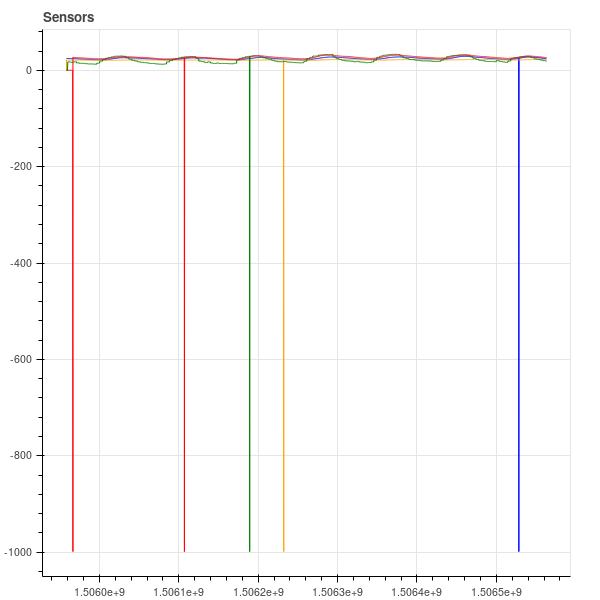Dynamic Imputation
CSE 662 Fall 2019
November 25
Missing Data
Missing Values
What is your age?
☐ 18-34
☐ 35-49
☐ 50-64
☐ 65+
☑ Prefer not to answer
Errors

Errors

Problem: You want to analyze a new dataset where specific values are missing or clearly wrong.
Drop Invalid Data
SELECT * FROM R WHERE X IS NOT NULL- Advantages
- Easy and fast.
- Compatible with scale-free aggregates (max, min, avg).
- Disadvantages
- Breaks scaling aggregates (sum, count).
- Can be unsafe if data is correlated.
Interpolation
$X_i = \begin{cases} X_i &\textbf{if } \exists X_i\\ \frac{X_{i+1}+X_{i-1}}{2}& \textbf{otherwise}\end{cases}$
- Advantages
- Can be fast.
- Rarely a problem with correlations.
- Disadvantages
- Requires an appropriate order...
- ...if one even exists
"Hot Deck" Imputation
Replace invalid values with the last valid value
- Advantages
- Usually Accurate.
- General.
- Disadvantages
- Requires shuffling and/or sorting.
Mean Value Imputation
Replace invalid values with the column mean
- Advantages
- Easy and somewhat fast.
- General.
- Disadvantages
- Requires computing the mean.
Classifier Imputation
Replace invalid values with the column mean
- Advantages
- General.
- Resilient to correlations.
- Disadvantages
- Requires training a classifier.
Missing Values
- Drop Missing Values
- Fast
- X Imputation
- Accurate
Which to use?
Observations
- Some columns are not relevant to the current workload.
- Some rows will get filtered out by query operators.
- Joins might fill in missing correlations.
Idea: Make the query optimizer aware of imputation needs.
In-Engine Imputation
Two new operators enforce COLUMN NOT NULL constraints.
- Drop ($\delta_{C}$)
- Non-blocking operator discards tuples if $C = \texttt{NULL}$.
- Impute ($\mu_{C}$)
- Blocking operator that replaces $C$ when $C = \texttt{NULL}$.
- Train + Repair in one step.
Challenges
- $\delta$ or $\mu$?
- Where in the plan to repair?
Basic query optimization problem!
The user manually identifies "dirty" input table columns.
Intuition: An attribute is dirty if it contains nulls that must be repaired.
Constraint: A dirty attribute must be repaired before it is used (e.g., by a selection or aggregate).
Question: Which columns are dirty?
$$\textbf{Dirty}(R) = \text{The dirty columns of R}$$
$$\textbf{Dirty}(\pi_C(q)) = \textbf{Dirty}(q) \cap C$$
$$\textbf{Dirty}(\sigma(q)) = \textbf{Dirty}(q)$$
$$\textbf{Dirty}(q_1 \bowtie q_2) = \textbf{Dirty}(q_1) \cup \textbf{Dirty}(q_2)$$
$$\textbf{Dirty}(\delta_C(q)) = \textbf{Dirty}(\mu_C(q)) = \textbf{Dirty}(q) - C$$
Cost Model
↓
Original Query → Optimizer → Optimized Query
A Classical Query Optimizer
- Selection Pushdown
- Join Reordering
- Join Selection
- Projection Inlining
- Dead Code Elimination
- ... and more ...
Optimization Rules
When a query subtree matches a specific pattern...
... (optionally) replace it with a different pattern.
Imputation
Question: How to inject repair operators?
Challenge: Changes require re-evaluating the cost model.
Idea: Restrict variations in columns being repaired.
Imputation
Before each operator...
- Repair only dirty columns used by the operator.
OR
Repair all dirty columns in the input. - Drop OR Impute
($2\times 2 = 4$ options for each operator)
Optimize the query normally.
Try every plan that satisfies the constraint on dirty columns.
Optimize for precision and time.
Accelerating the Search
- Cache performance/cardinality/dirty column results for intermediate subtrees
- Drop/ignore subtrees with the same dirty column set that are worse in both time and precision than another plan.
Cost Model
Need to predict the computational cost of the plan.
Need to predict the accuracy of the result.
For both, we need histograms.
Histograms
Propagating per-column histograms is a standard part of query optimizers
How do $\delta$ and $\mu$ propagate histograms.
- Figure out the number of rows (cardinality) after the operator.
- Rescale the histograms to the new number of rows.
Drop ($\delta_C$)
Conservative assumption of full overlap between NULLs
- $\textbf{card}(\delta_C(R)) = \textbf{card}(R) \cdot \max_{col}(R.col.\text{hist}[\texttt{NULL}])$
- $\delta_C(R).col.\text{hist}[v] = R.col.\text{hist}[v]$ (except $v = \texttt{NULL}$)
Impute ($\mu_C$)
Assume distribution of values unchanged
- $\textbf{card}(\mu_C(R)) = \textbf{card}(R)$
- $\mu_C(R).col.\text{hist}[v] = R.col.\text{hist}[v] \cdot \frac{\textbf{card}(R)}{\textbf{card}(R) - R.col.\text{hist}[\texttt{NULL}]}$ (except $v = \texttt{NULL}$)
Estimating Precision
Given: Penalty function $P(\mu_C(q)) \in [0,1]$
0 = perfect replacement
1 = as bad as dropping all columns in $C$
Example: Decision Trees
$$|C|\cdot \frac{1}{\sqrt{|\textbf{attrs}(q)|\cdot \textbf{card}(q)}}$$Query Penalty
$$L_P(q) = \begin{cases} 1 + L(q') & \textbf{if } q = \delta_C(q') \\ P(q) + L(q') & \textbf{if } q = \mu_C(q') \\ L(q_1) + L(q_2) & \textbf{if } q = q_1 \bowtie q_2\\ L(q') & \textbf{if } q = \sigma(q') \textbf{ or } q = \pi(q')\\ 0 & \textbf{if } q \text{ is a table} \end{cases}$$Total penalties judged relative to a plan that drops all attributes.
Estimated Query Cost
Handled as normal by the query optimizer.
- $\delta_C \approx \sigma$
- $\mu_C$ cost estimated by given function $T(q)$.
Concerns
Later imputation means more opportunities to drop tuples naturally, but some joins produce larger output relations.
Larger data is sometimes better (more opportunities to find correlations), but not always.
Concerns
Penalty function is measured per-operator rather than per-column.
- Advantages
- Biases search towards fewer repair operators.
- Disadvantages
- One bad imputation for 2 columns may have a lower penalty than 1 good imputations for 1 column.
- Does not measure the impact of dropping non-null values.
- Penalty effects not scaled by cardinality.